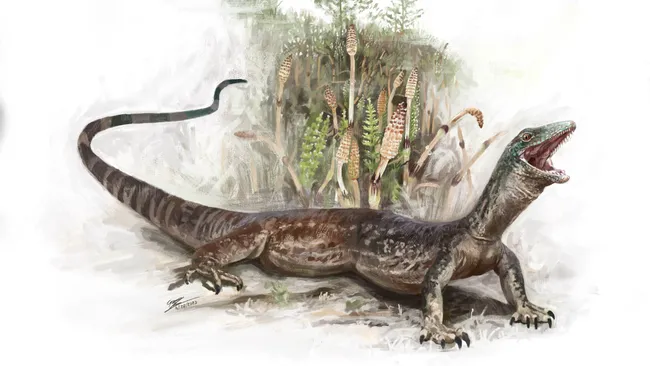A team of paleontologists has uncovered a remarkable fossil on Scotland’s Isle of Skye — a mysterious Jurassic reptile with both lizard and snake-like traits. The discovery of Breugnathair elgolensis, meaning “false snake of Elgol,” is helping scientists unravel the origins of snakes and lizards during the Jurassic period, 167 million years ago.
A Jurassic Predator with Python-Like Teeth
The fossil reveals a reptile just 16 inches (41 cm) long, but still one of the largest lizards in its ancient ecosystem. Breugnathair elgolensis had curved, hooked teeth resembling those of modern pythons, perfectly adapted for catching prey. Researchers believe it hunted small lizards, early mammals, and even young dinosaurs such as tiny herbivores and bird-like predators.
Its anatomy was a fascinating mix: a snake-like jaw and teeth, but a short body with fully developed limbs like a lizard. Some of its skull bones even showed gecko-like features, making it a true evolutionary mosaic.
The Fossil’s Long Journey from Discovery to Breakthrough
The fossil was first unearthed in 2015 near the village of Elgol by Stig Walsh, senior curator at National Museums Scotland. Over the past decade, researchers used advanced X-ray and CT scanning to reconstruct its anatomy in unprecedented detail.
The study, published in Nature, places B. elgolensis within a little-known squamate group called Parviraptoridae. Until now, this group was only identified from fragmentary fossils. The new specimen confirms that snake-like and gecko-like traits could coexist in one animal — rather than belonging to two different species as previously assumed.
A Window into Snake Evolution
Snakes and lizards both belong to the reptile order Squamata, which originated around 190 million years ago. While lizards typically retain four limbs, snakes evolved limbless bodies and highly specialized jaws.
What makes B. elgolensis so significant is that it blurs the line between these two forms. According to study co-lead author Susan Evans of University College London:
“The mosaic of primitive and specialized features we find in parviraptorids, as demonstrated by this new specimen, is an important reminder that evolutionary paths can be unpredictable.”
Still, scientists remain cautious. It’s unclear whether snakes directly evolved from creatures like B. elgolensis, or whether they developed snake-like features independently.
Changing the Puzzle of Early Reptiles
For researchers, this discovery is like uncovering the missing picture on a jigsaw puzzle box after decades of guesswork. The fossil shows that snake-like jaws and teeth were already evolving in the Jurassic period — long before true snakes appeared.
Study lead author Roger Benson of the American Museum of Natural History summed it up:
“This fossil gets us quite far, but it doesn’t get us all of the way. However, it makes us even more excited about the possibility of figuring out where snakes come from.”
